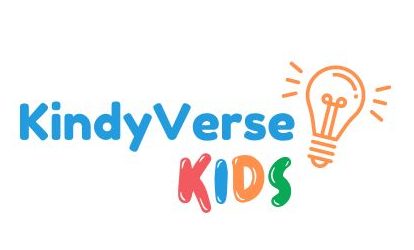All Things you Need to Know About Kindergarten Worksheets
by Mia and Arvie
A worksheet by definition is a piece of paper that students are given by their teachers and on which specific academic tasks are listed. This piece of paper can be use in different academic subjects such as math, English, and geography.
Children ages five-years-old or above are considered as kindergarten. This is the time where they have developed social, physical, and basic academic skills.
Kindergarten stage helps them to enhance all these skills, and to learn more. In what way? Through using worksheets and of course, guidance from their teacher and you-as their parents.
So, what is the importance of a worksheet for a kindergarten? Is there any advantage that a student could get if they are using worksheets? All this, and MORE will be discussed in this article.
7 things you will learn at the end of reading this article:
Kindergarten Topics and Worksheets
-
-
- Importance of Worksheets for Kindergarteners
- How Do Worksheets for Kindergarteners Help the Educators and the Parents?
- How to Make a Worksheet (using Canva)
- Kindergarten Worksheets in PDF and Printable
- How to Make Worksheets Fun?
- A Guide to How to Properly Use Worksheets
-
Kindergarten Worksheets are learning tools or learning materials that help the students to exercise and assess their learning. Children are taught to remember or to familiarize the items in a subject that will serve as their foundation to advance learning then to prepare themselves for school age where they will be exposed to various skill sets and techniques to absorb information.
Worksheets for kindergarten are categorized based on the subjects suitable for their age. Since most kindergarteners’ age is 5 years old, their cognitive capacity and motor skills are ready enough to be pumped out and assessed as they have developed enough skills for the worksheets.
The following kindergarten subjects for worksheets are the following:
-
-
- Math
- Fine Arts
- Foreign Language
- Reading and Writing
- Science
- Social Studies
- Social Emotional
- Typing
-
Now that you know what subjects or topics are being covered in a kindergarten worksheet, the following will give you a better and more comprehensive idea about kindergarten worksheet.
Kindergarten Math Worksheets
Math worksheets help kindergarteners to sharpen their mental capacity to count, perform equations, solve problems, and analogy. It helps kindergarteners to process situations and their ideas in a logical and rational way.
The following are examples of topics in Math worksheets:
-
- Addition
- Subtraction
- Patterns
- Time
- Money
- Measurements
- Numbers
- Counting
- Shapes
- Greater than, less than, or equal to
Kindergarten Fine Arts Worksheet
Fine Arts worksheets are the best way to practice their hobbies to skills. In this topic, children will learn how to be creative and recognize similarities and differences, and decision making when creating from nothing to something.
The following are examples of topics in fine arts worksheets:
-
-
- Tracing
- Connect the dots / Dot-to-Dot
- Coloring
- Drawing
- Nursery rhymes
- Color by number
- Cut out, sort and paste
- Pattern
- Instruments
-
Kindergarten Foreign Language Worksheets
Teaching children a foreign language is one of the best things you can do for your child. Not only does it enhance a child’s cognitive capacity and memorization but it can be very useful and beneficial for a child’s communication skills.
The following are examples of topics in foreign language worksheets:
-
-
- Hiragana
- Russian
- Chinese
- Hindi
- Spanish
- Fruits and vegetables from different countries
-
Kindergarten Reading and Writing Worksheets
Reading and writing worksheets are beneficial for words or sentence construction. It is being used in our everyday lives, making it more important to be taught and be skillful enough for conversing.
This subject is important to help boost memory in absorbing information, ability to multitask, and give advantage for life-long learning.
The following are examples of topics in Reading and Writing worksheets:
-
-
- Reading comprehension
- Writing
- Synonyms, Antonyms, Homonyms
- Alphabet
- Sight words
- Phonics
- Spelling
- Grammar
-
Kindergarten Science Worksheets
Science worksheets most likely to tackle the environment a 5-year-old child always sees and observes. The benefit of learning science at this age is they learn how living things, parts and nature work and coexist in one place.
The following are examples of topics in science worksheets:
-
-
- Parts of the human body
- North American wildlife
- Bugs and insects
- Human senses
- Animals and their habitats
- Anatomy
- Astronomy
- Weather
- Experiments
- Life cycle
- Parts of plants
-
Kindergarten Social Studies Worksheets
Social Studies worksheet’s purpose is to give recognition for the cultural differences, places, and contributions of people to build a better community.
In order to understand such differences, introducing subjects and subtopics under this topic makes them learn acceptance and gratefulness.
The following are examples of topics in community and culture worksheets:
-
-
- Community and Culture
- Community workers and helpers
- Government
- Famous places
- Chinese Zodiacs
- Countries and their flags
- Famous people and their contributions
-
Kindergarten Social Emotional Learning Worksheets
Social Emotional Learning worksheets tackles about personality development of a child during their kindergarten age. It is important to teach them manners and ethics as early as possible. It helps to bring out the best behavior of a child that will bring great impact in a long-term process.
The following are examples of topics in social emotional learning worksheets:
-
-
- Mindfulness
- Relaxation exercise
- Control yourself
- Decision making
- Collaboration
- Know yourself
- Learning emotions
- Resolving conflicts
- Facial expressions
-
Kindergarten Typing Worksheets
Typing worksheets is a reasonable skill that a child can learn at an early age. Children are more inclined to the use of technology, computers to be exact, and this is like an advanced skill for those who are able to type fast and a good showcase of precision and coordination of body and mind.
The following are examples of topics in typing worksheets:
-
-
- Home keys practice
- Typing sentences
- Typing punctions
- Where do my fingers go?
- Capital letters and small letters
-
How Do Worksheets for Kindergarteners Help Teachers and Parents?
There are a lot of reasons and ways on how do worksheets help the teachers and the parents. In general speaking, it saves time and effort in giving instructions to the children on how to do tasks. Most worksheets have titles, topics to be discussed, what a child will learn after completing the worksheet, brief introduction, directions, the lesson, the assessment, and the conclusion.
Throughout laboratory analysis, well-designed worksheets could indeed support teachers in overcoming time constraints and enhancing students’ acquisition of knowledge and skills. It is said that worksheets are supplements to textbooks and it is somewhat true. The purpose of the worksheet is to provide assessments for the students and give other supporting details regarding the topic.
Kindergarten Worksheets in PDF and Printable
If you look up on the internet and search for kindergarten worksheets, you will see a bunch of sites with words like “browse” or “search” in their titles.
It is because many websites and educators have been uploading and making worksheets on different topics and concepts for the students or kindergarteners.
Most of them are downloaded files or printable files so that the teachers or the parents will save their time making worksheets and can teach their children even at home.
Worksheets have been integrated and used for a long time now to assist the kindergarten in their learning and development.
Is it Effective / Useful to have the Worksheets in PDF or Printable?
Worksheets in PDF format or printable are easy to utilize because they are made just the way they are. Concise and Functional.
Is it effective or useful? The answer is Yes. Imagine the struggles making assessments and handouts every time when there are existing worksheets based on the standard topics or lessons to be discussed to a student constructed by age level or grade level and cognitive capacity.
Worksheets Functionality
According to Che-Di Lee in their research, every part of worksheets has its own “functionality.” For instance, blanks in worksheets serve as the way for the student to construct their knowledge upon answering. Provided below are the other functionality that was mentioned in their research.
-
-
- Enhance knowledge through investigation – worksheets allow the student to enhance their acquisition of their knowledge and skills. Additionally, time is being utilized well. Meaning they did not need to spend longer time in order to discuss and observe the activity, instructions are provided on the worksheet.
- Advance Organizers – when student having a school field trip and visiting other places worksheets can be the “advance organizers.” It gives assistance and guidance to the students in order to organize their observations and knowledge in a perplexing learning environment.
- Keep focus – worksheets functionality allows the students to focus on a particular object because it enables the teachers to structure the visit. This helps to get the attention of the students.
- Understanding the outcome – As per the research, worksheets help the teachers to understand the student’s prior knowledge, learning outcomes, and learning processes; they can also be used by students to monitor their own learning progress.
-
These are just a few functionalities of the worksheets that benefit the academic journey of both teachers and students. Now that we know this, let us discuss next a guide on how to properly use worksheets.
A Guide to How to Properly Use Worksheets
Even giving worksheets to our child needs to be thoroughly planned and putting effort is a must. So, to give a little guide provided below are some of the tips and guide on how to properly use worksheets.
-
-
- Make sure to give worksheets based on the age level and cognitive understanding of a child.
- Give worksheets that are easy to understand and answer. Make their learning journey fun and memorable.
- It is advised to give a worksheet with familiar situation, characters, and objects to get the interest of the child. Also, including a practical and real-life activity in a worksheet can be really helpful.
- As mentioned in the previous section of this article, worksheets are meant to help the students remember their prior knowledge. Children might forget some of what they have learned, hence, it is important to help them remember through worksheets.
- Encourage a child by giving him or her positive feedback and praise.
- Assess and ask your child if they can write. According to Lisa Wilkinson, there are different stages of a child and their ability to hold pencils.
-
-
-
- At 1 and a half years old, a child can do the “fisted grasp”. In other words, they hold a pencil or crayons in a closed fist.
- At two to three years old, typically children develop fine motor skills. Most of them hold a pencil in a “Palmer Grasp.” Pencil rests on the palm of their hand.
- At about 3 and 4 years old, most of the children can hold a pencil using their three or four fingers, Wilkinson called it “Static Tripod or Quadruped Grasp.”
- The final stage is “Dynamic Tripod Grasp.” For children aged 4 to 6 years old, they now can move their fingers independently, that allows them to draw and write freely.
-
With this research, observe your child if they can already write, or at least show the interest to write. If your child is not comfortable, it is better not to force them. After all, children have their own pace of learning.
There are many ways to get better worksheets that follow the tips above. You have a lot of options in order to provide the best learning experience for your little one. Might be wondering if you could create your own, do-it-yourself worksheet for your child? Worry no more as the next article will teach you how.
How to make worksheets for kindergarten at home?
You may be a type of parent or a guardian that wants to make an extra effort to teach your child-we admire you for that. Maybe you are asking how to make personalized worksheets for your kindergarten? Worry no more as we will guide you on how to make worksheets even at the comfort of your home.
First let’s utilize the internet so get your laptop or even your mobile device, and let’s keep the ball rolling.
Have you ever heard of Canva? The comfort it can give to its user, and for those who know Canva, you probably agree with me that it always saves our day-especially those who are not into digital arts but somehow need to create a simple poster for their business or school work.
This is the step-by-step process on how to utilize this web application (or even mobile, yup Canva has mobile version too.) Let us focus first on the web application.

Step 1: Navigate to Canva.com you may click this link, or type to your search engine “Canva.” Click the first thing that you see on your web browser.
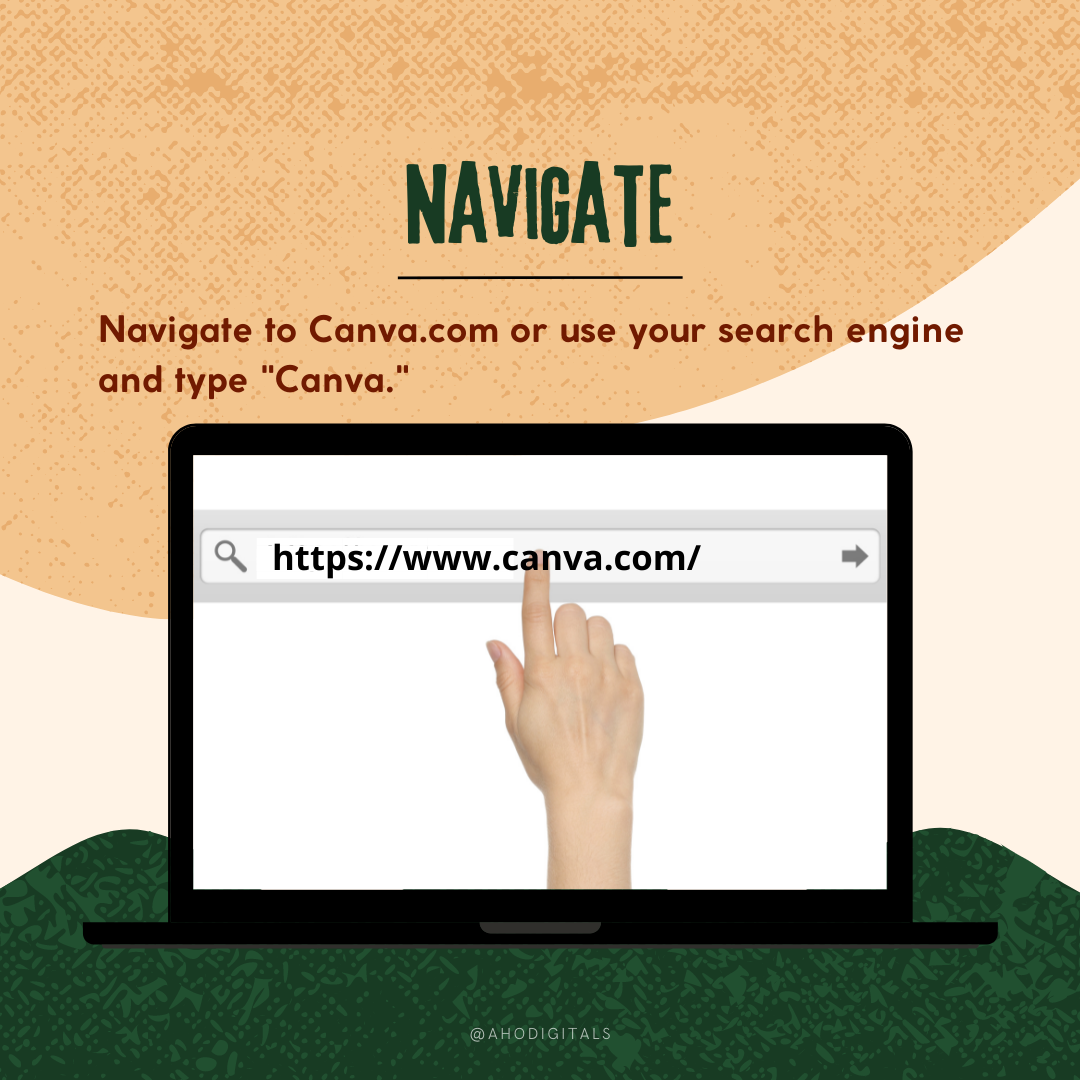
Step 2: Welcome to Canva! You may be overwhelmed right now with all the available templates but you could use the search feature to find worksheet templates that you could customize.

Step3: There are a LOT of features that you could also use for free in creating a customizable template for worksheets. Explore, do not be scared of trying those features, it was there to help you create a unique and fun worksheet. You could add frames, icons, images, and even paragraphs and other elements.

Step 4: Personalized your template, and own it as you made it. Yup, you could delete other elements that you think did not fit on your worksheets. You can also add more. Keep on editing until you satisfy your standards for the worksheets of your children.
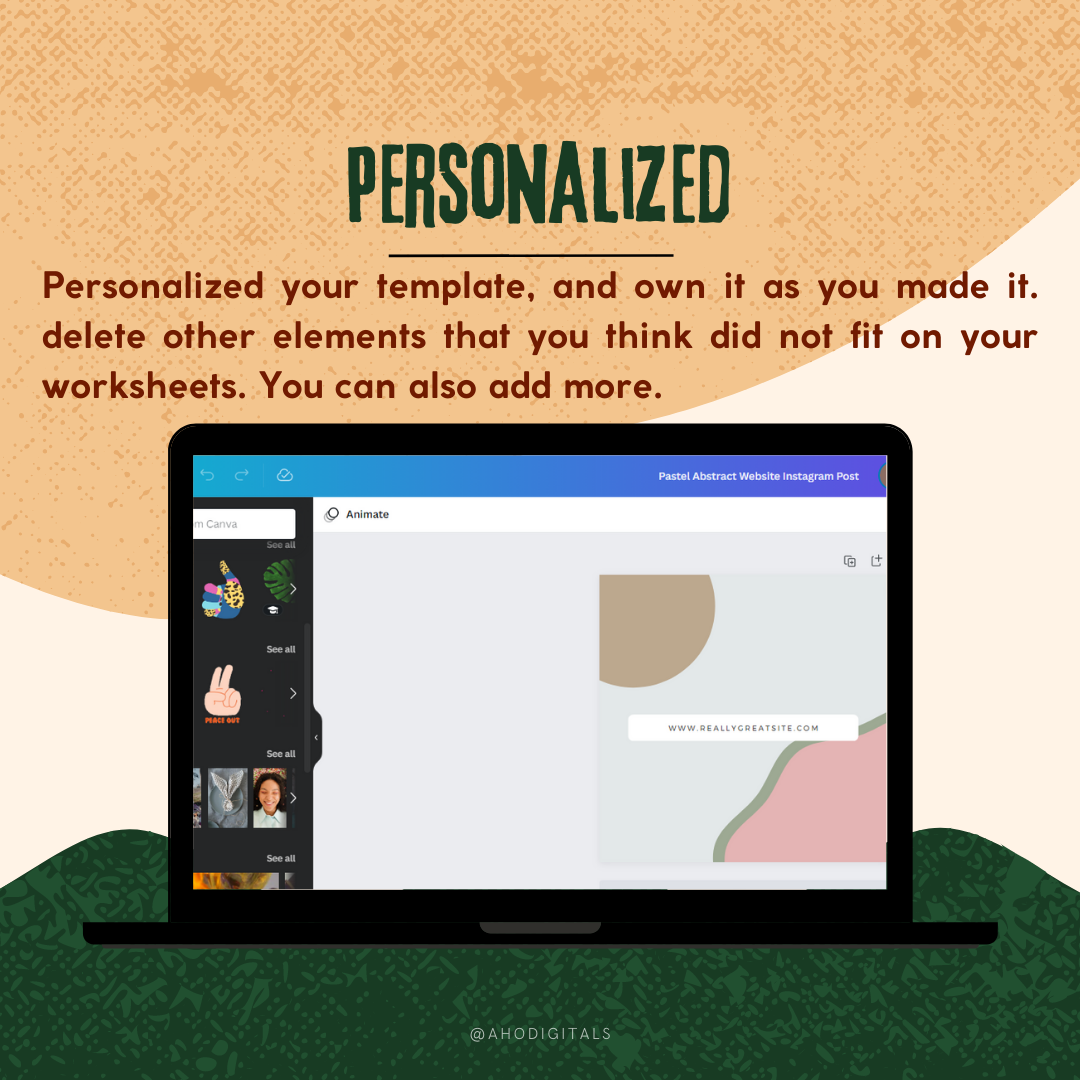
Step 5: Publish and Download.
Some templates may need payment in order to be downloaded, but there are a bunch of templates that we could use for free. Now, are you satisfied with the result? You click the arrow down button or click the share button then download, Canva will make you choose either to download the template in PDF, PNG, JPG, and other available formats. For a worksheet, let’s download it as PDF.
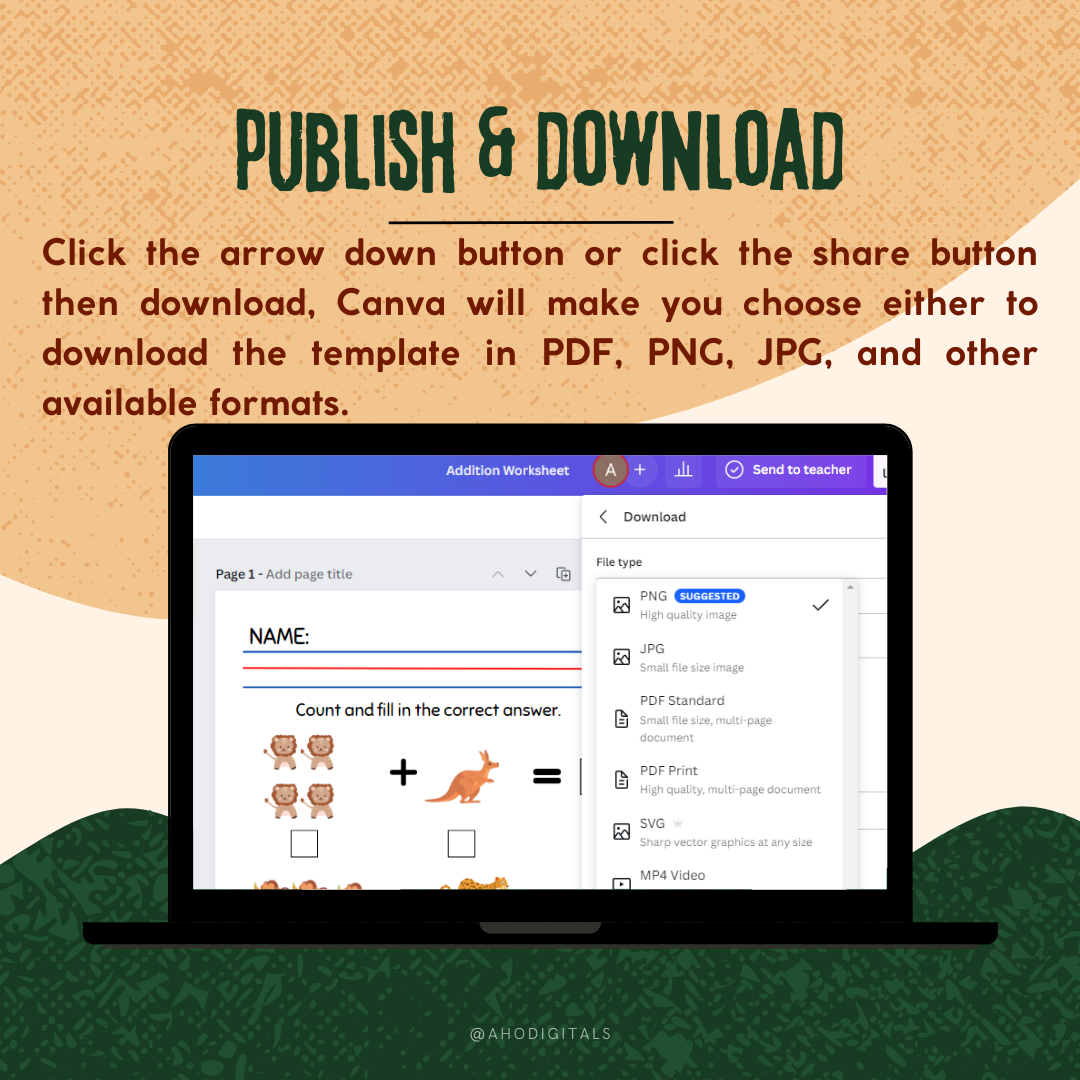
So here is the sample worksheet:
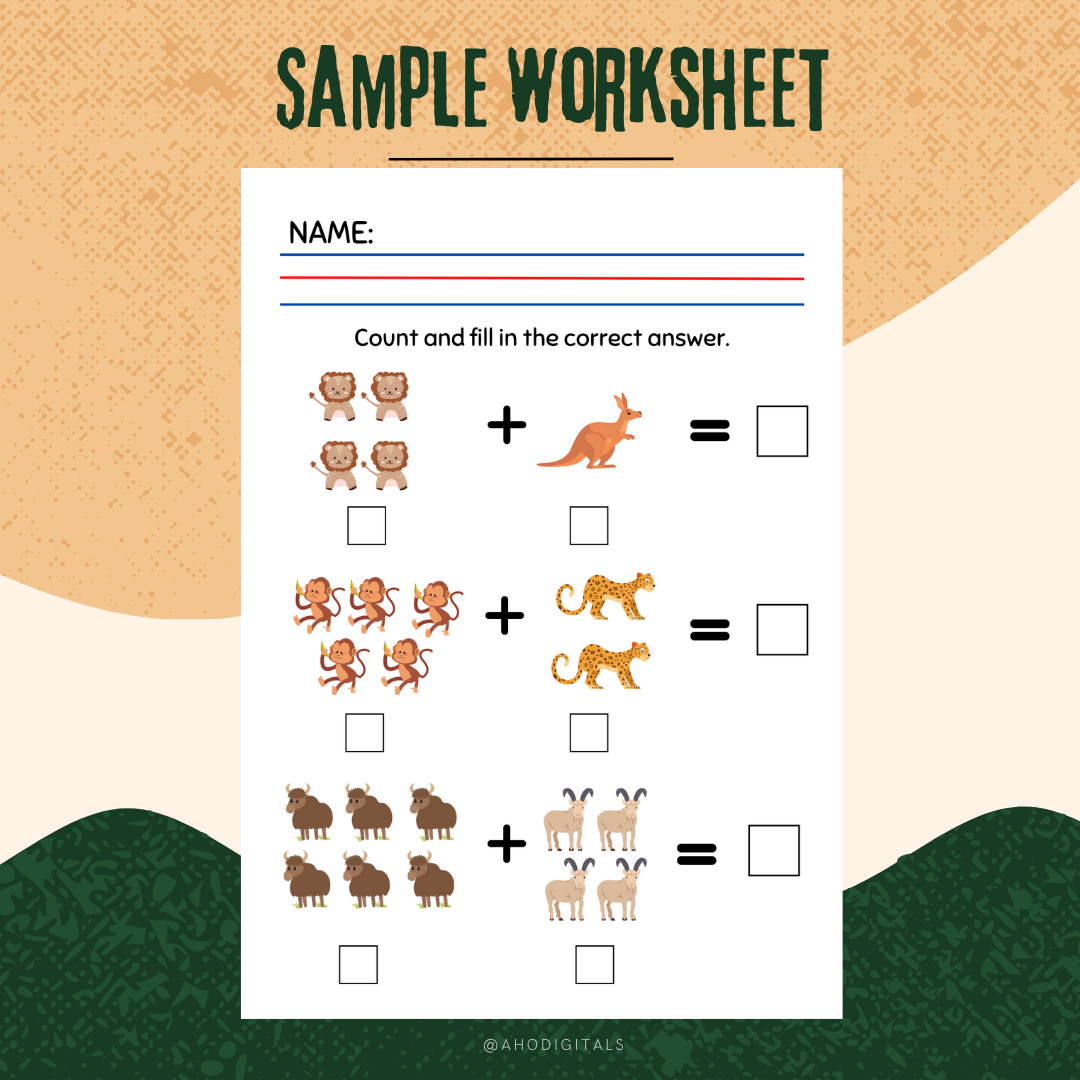
You might be wondering; how should I make this “editable”? Or You might have any means of printing this worksheet but you want your children or student to answer this through their computer. Well, continue to read as below is the provided tutorials on how to put an answer to a worksheet that are in PDF File.
How To Answer A Worksheet That Is In PDF Format?
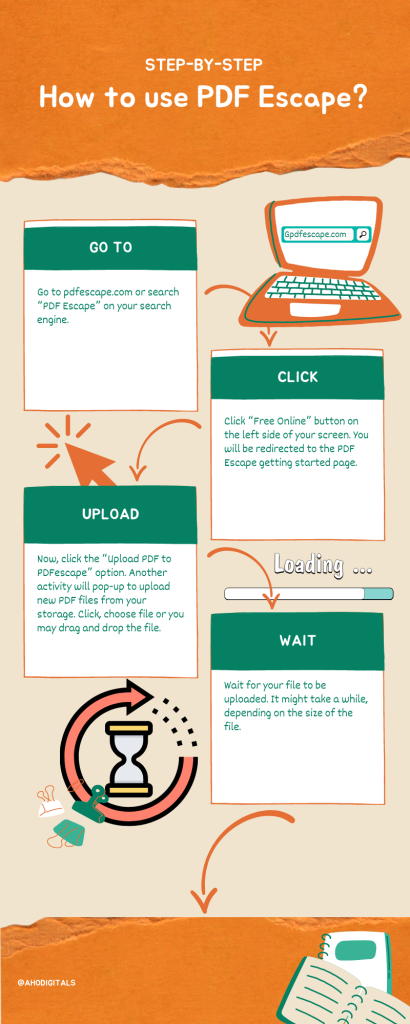
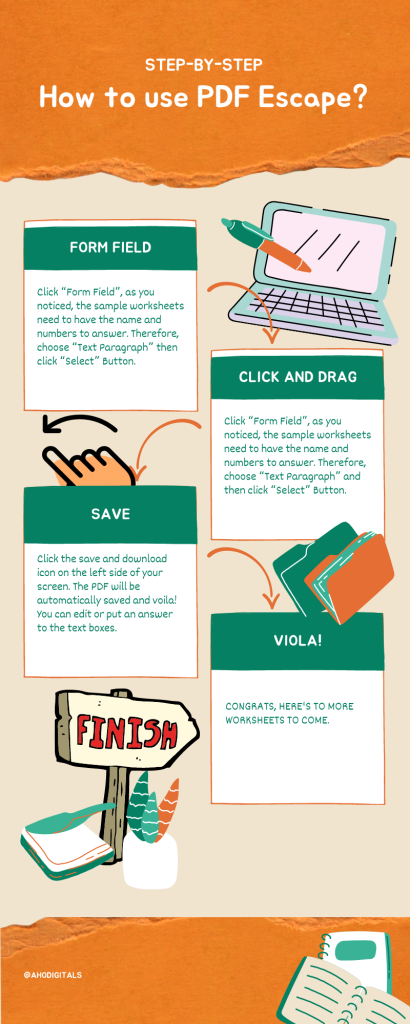
Step 1: Go To
Go to pdfescape.com or search “PDF Escape” on your search engine. PDF Escape is a free web application that allows you to edit PDF files, annotate, fill out, create basic PDF Forms, and many more. There is also a premium version that has an upgraded feature. Nevertheless, PDF Escape is a good application for this tutorial.

Step 2: Click
Click “Free Online” button on the left side of your screen. You will be redirected to the PDF Escape getting started page.
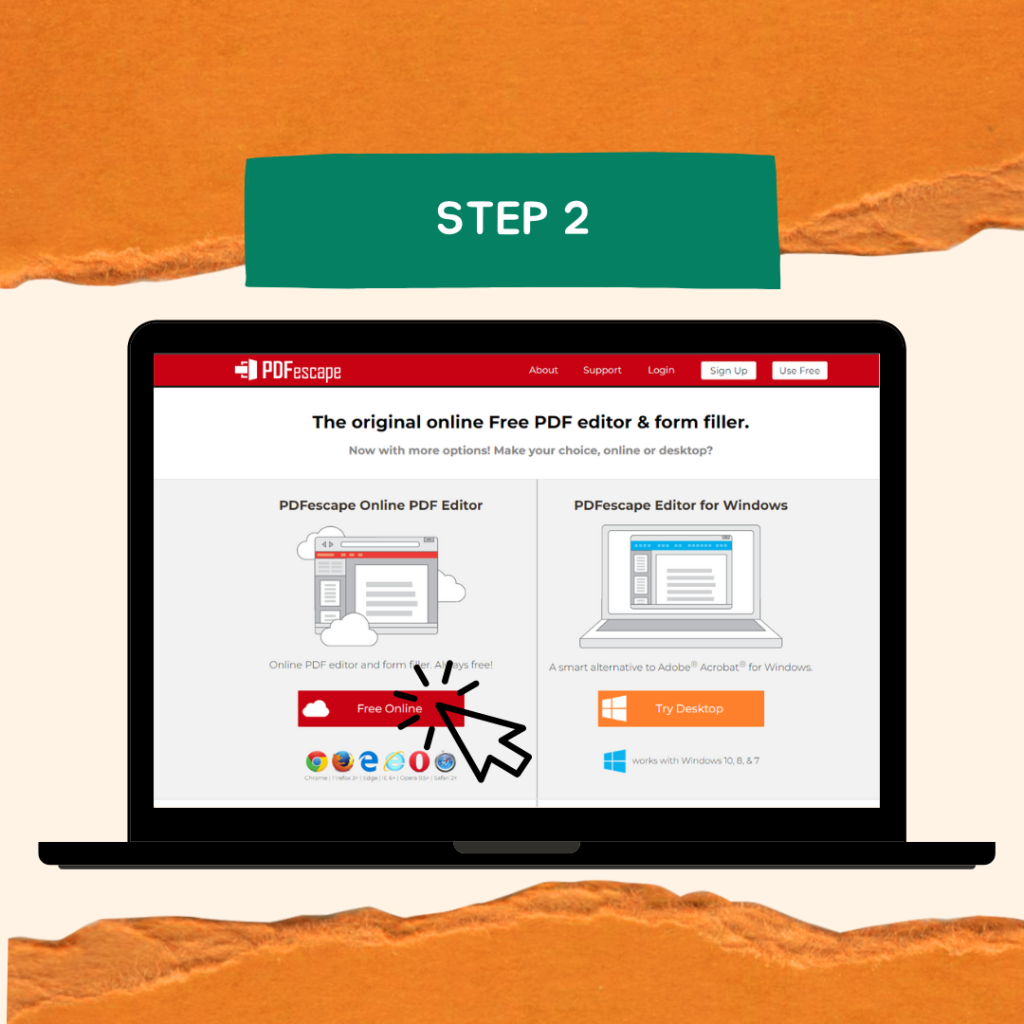
Step 3: Upload
Now, click the “Upload PDF to PDFescape” option. Another activity will pop-up to upload new PDF files from your storage. Click, choose file or you may drag and drop the file.
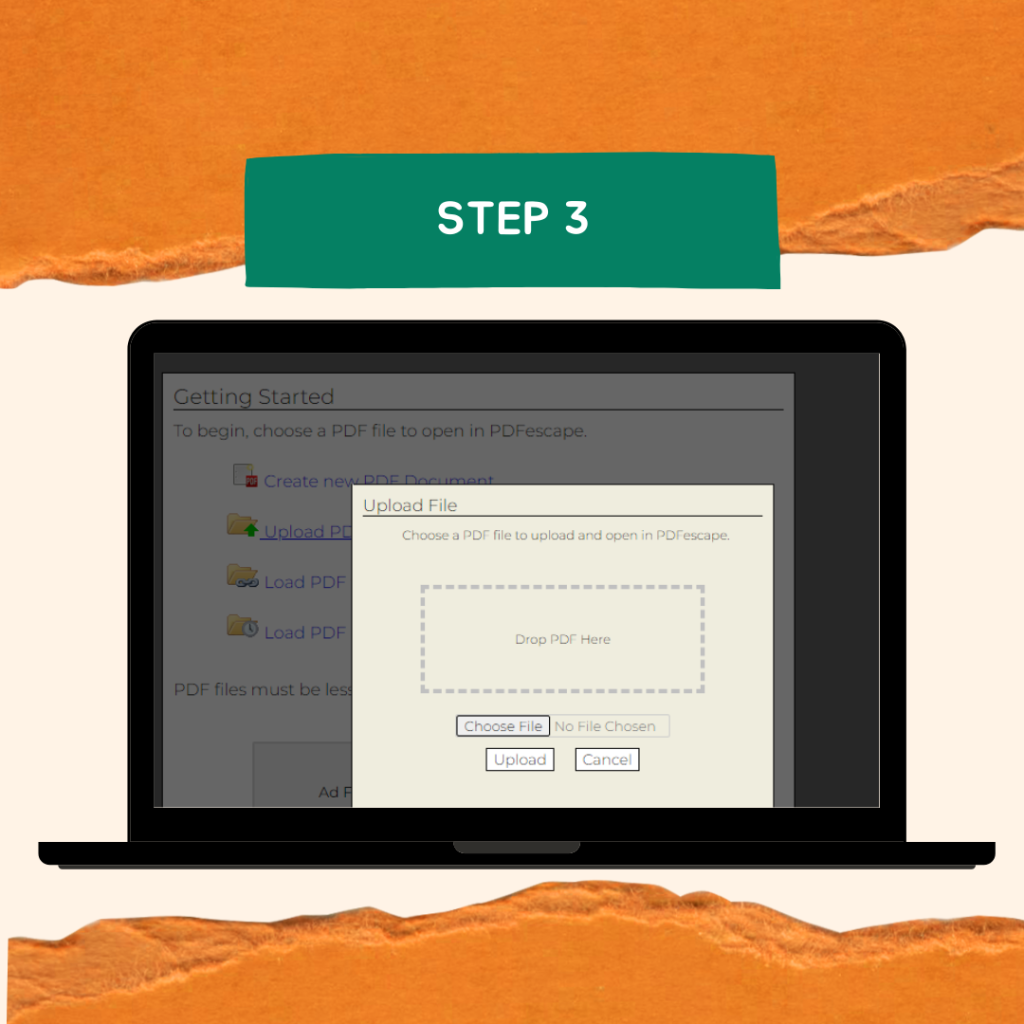
Step 4: Wait
Wait for your file to be uploaded. It might take a while, depending on the size of the file.
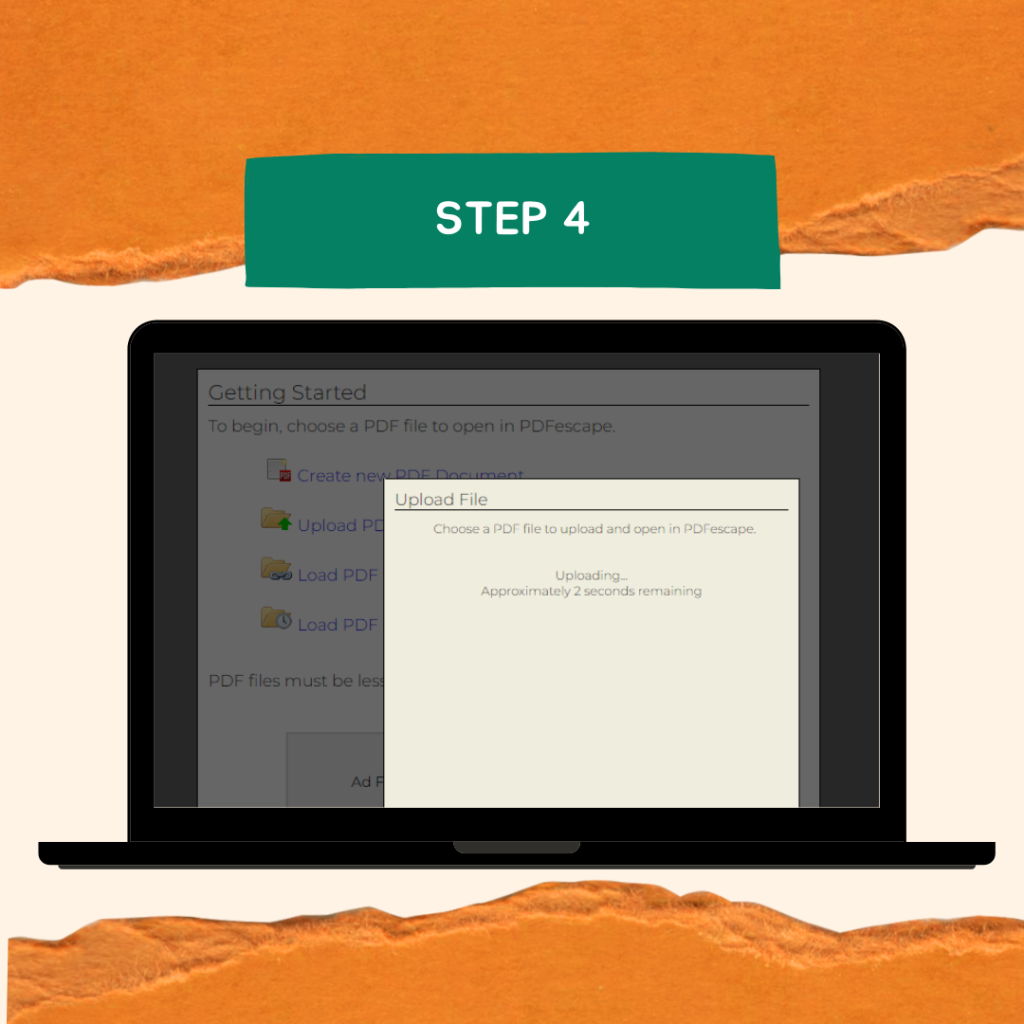
Step 5: Form Field
Click “Form Field”, as you noticed, the sample worksheets need to have the name and numbers to answer. Therefore, choose “Text Paragraph” then click “Select” Button.
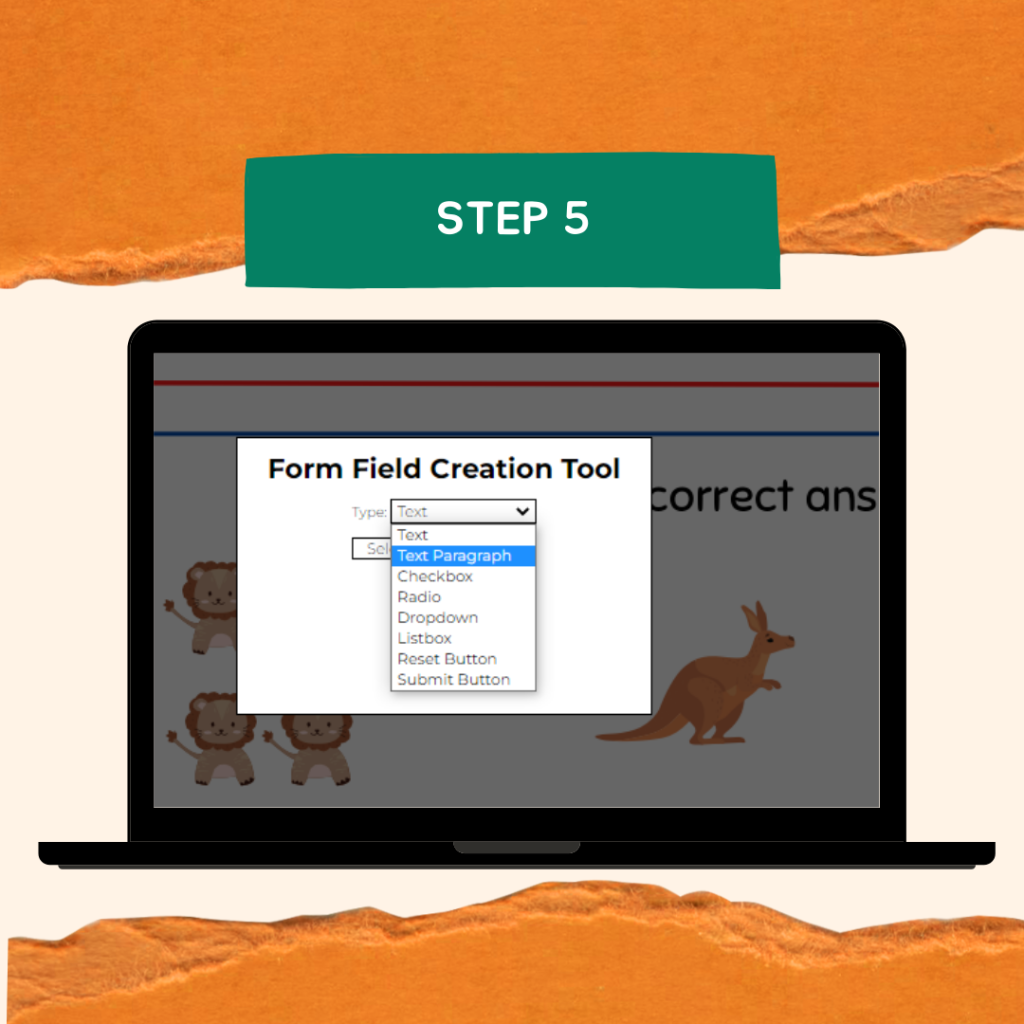
Step 6: Click and Drag
Click anywhere from the worksheets, where it needs to be answered. Remember that you can still edit the font style, size, and color depending on your preferences.
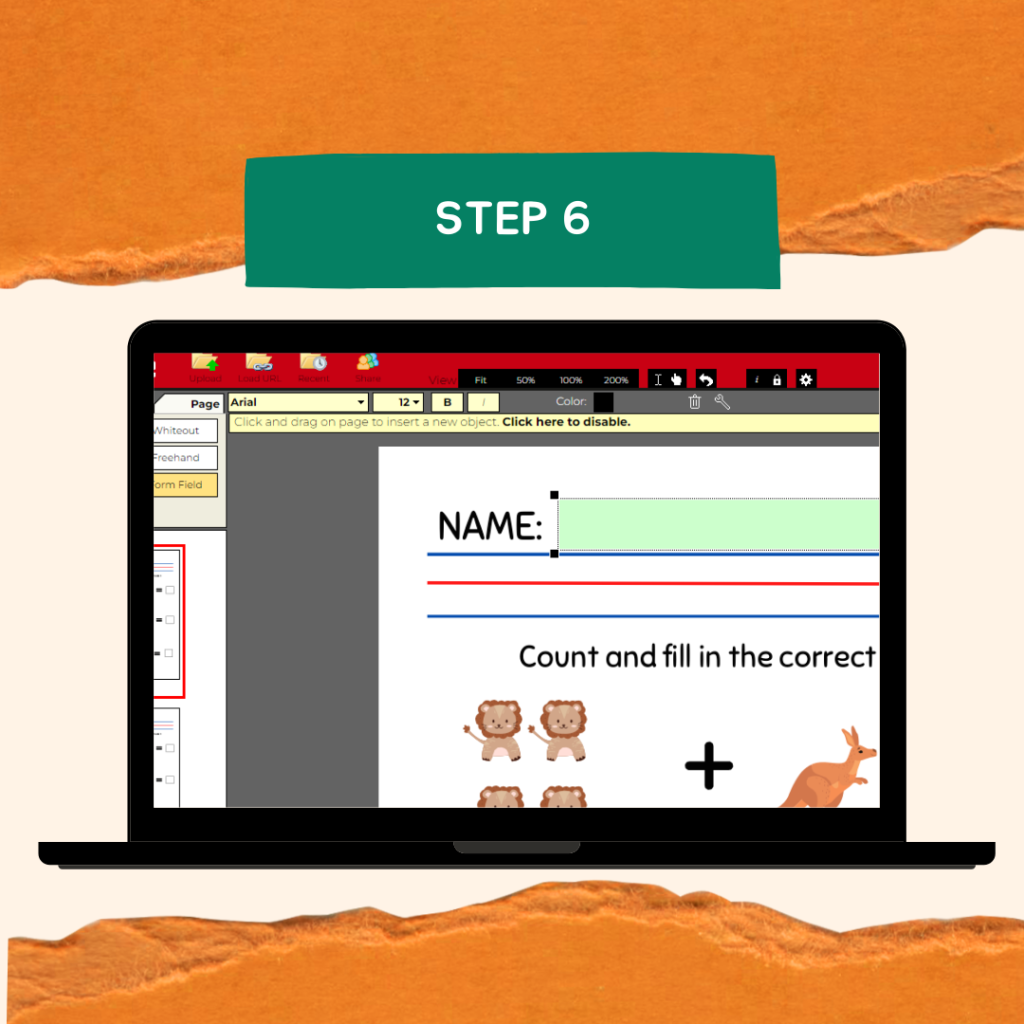
Step 7: Save
Click the save and download icon on the left side of your screen. The PDF will be automatically saved and voila! You can edit or put an answer to the text boxes.
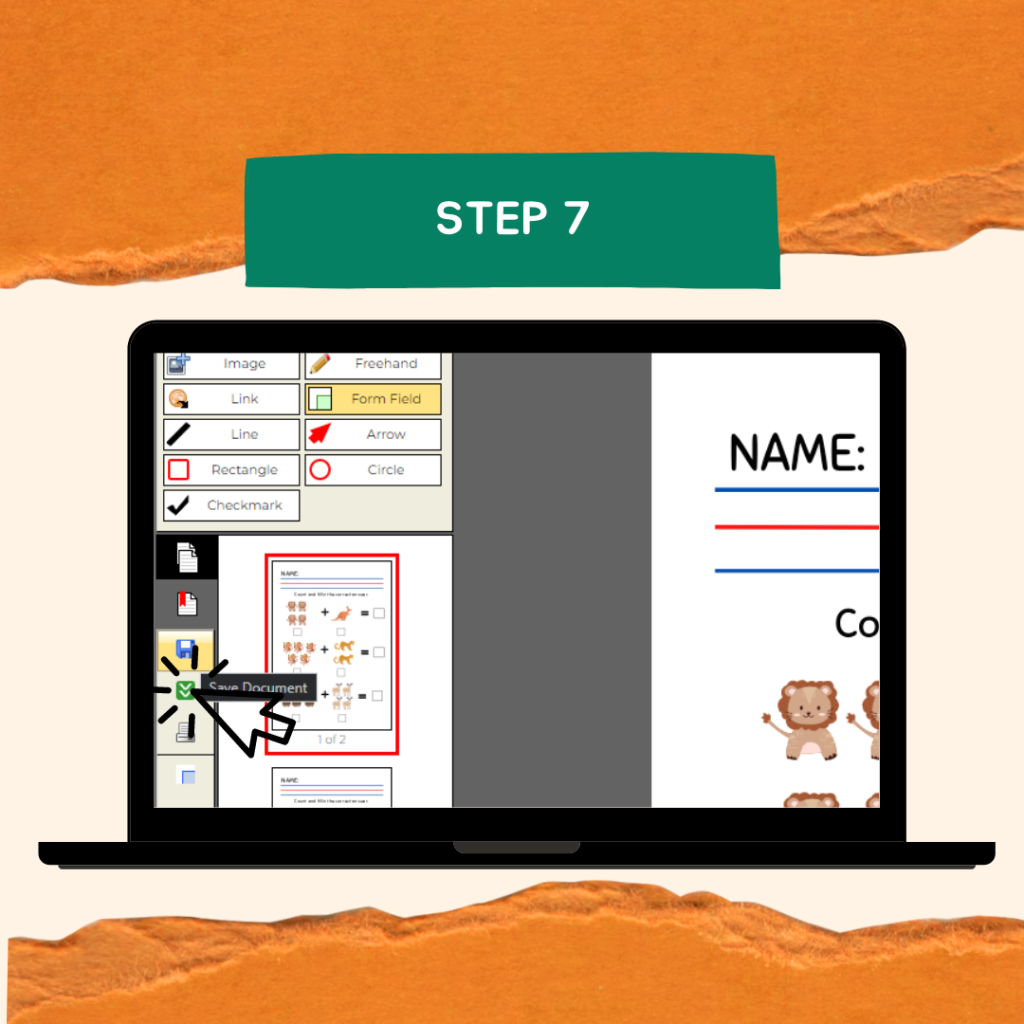
Now this is the Final output:
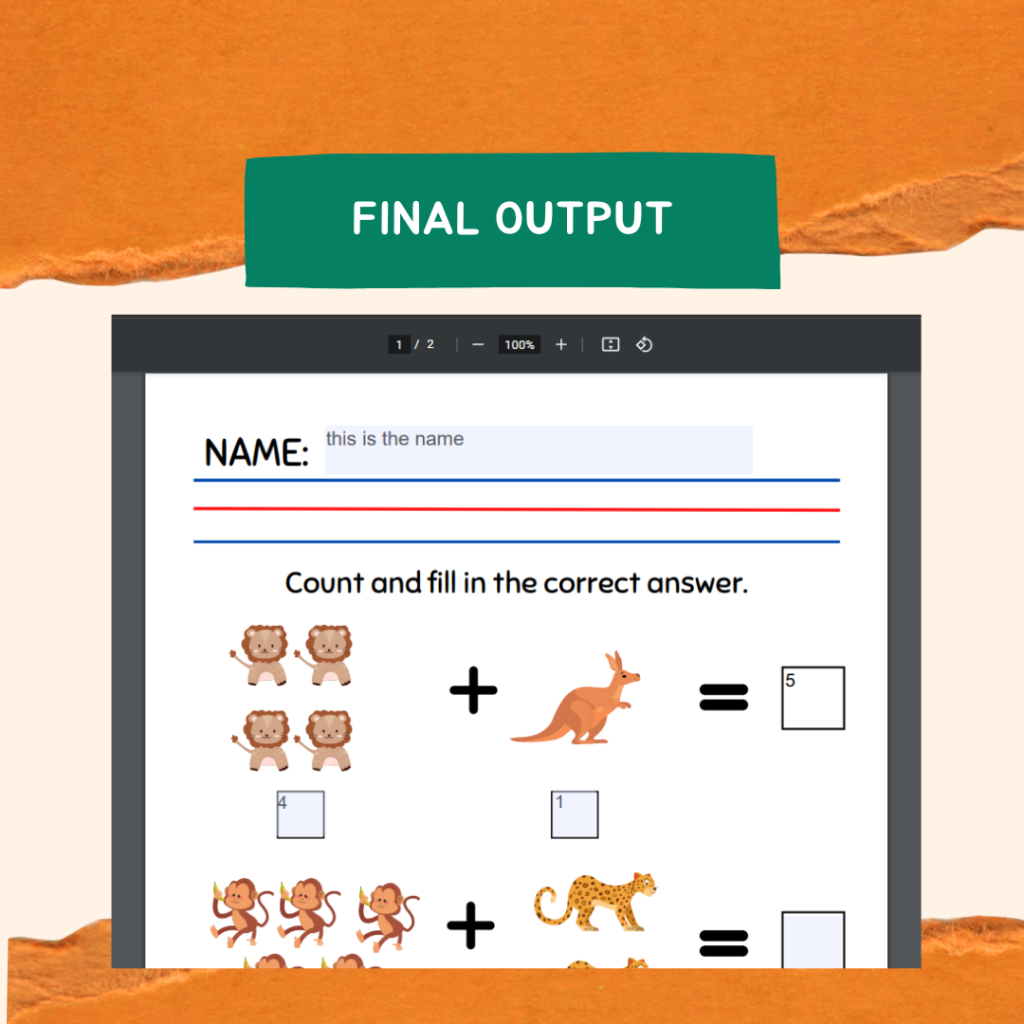
You could download the answered version and send it probably to your child’s teacher.
These are only one of hundreds of ways on how to create your own worksheets, you could also utilize crayons, piece of paper, and pen for DIY Worksheets. Just remember that we only have one goal to create and teach our children for the betterment of their future.
How can we make worksheets more interesting?
Well, now that we know how to create and print a worksheet, you might want to step into the next level. Creating an activity where worksheets are involved. It can be a game, dance, sing, or any activity that requires your child to be physically active.
Here are some activities from different websites that will help you achieve this goal.
First is from Create Inspire Teach, and this is SNOWBALL FIGHT. But, what about those countries who are not experiencing winter? Don’t worry, the worksheet will serve as the snowball in this activity. Try to cut the worksheets, and crunch. After that let them toss these in the center, get one snowball worksheet and toss. Until the time goes off, whatever worksheet they are holding, they have to answer this or at least read it out loud. Depends on what worksheet they are working on.
Second on our list is from the website TEACHER’S PAY TEACHERS, TEACHING TIPS. This activity is called “Have Students Complete Half.” The instruction is to let the child decide on which worksheet they want to complete; this activity aims to put less pressure on the child since they only need to answer half of the worksheet.
Third on our list was from the same website and caught our attention since this is really interesting and simple. Prepare some dry erase markers for the students to use while they are working on the worksheets, and laminate them for them to be used. Dry erase markers have a special effect on children. They like the waymarkers feel in their hands and how simple it is to erase and start again if they make a mistake.
Kindergarteners develop their skills to reason out, they can analyze the situation and give a reason for why it happened. So, the fourth on our list is from Truth for Teachers, read out loud a problem or question from a worksheet to your child. Give at least 30-60 seconds to share his or her thoughts with the person sitting across from them. Send a signal to each child to move one space to the right. Play the game until the child has answered all of the questions.
Expect that most of these children may feel shy in expressing their reasons, in this kind of situation encourage them to share and make them feel comfortable.
The fifth and last on our list is called “Online Educational Activity.” Most of us are aware that almost all children of any age are into technology. Parents at least gave them screen time to navigate to YouTube Kids or play computer games. Hence, incorporating technology to educate them would be beneficial. Let them have time to play educational games.
Provided below is the website that you could use to help your children learn more through the use of technology. So, continue to scroll, sit back and relax as the next topic will discuss KindyVerse.
Resources for reliable and free worksheets
You might be wondering where you can find free worksheets that cater to all the subjects mentioned in this article? Worry no more as we will introduce to you the KindyVerse, a website that offers reliable, free, and downloadable worksheets that you and your children can use it.
Kindy Verse has several topics that you could choose. These are:
-
-
- Alphabet
- Writing
- Coloring pages
- Reading
- Chess
- Games
- Nursery Rhymes
- Social Studies
- Science and
- English for beginners
-
To know more on what can we find on this website, let’s elaborate Kindy Verse offers Trace the alphabet, Letter Tracing, Color the Animal Alphabet, and Writing letters. Coloring pages allow the kindergarten to color particular objects and directions. There is so much more to explore on this website.
Additionally, Kind Verse has worksheets not just for preschool and kindergarten, but also for Grade one, two, and three. And did I mention that they have learning games? Yes, you read it right. This website offers fun and interactive activities for our children to learn. Learning games include tracing numbers, types of clouds, solar systems, and space travel.
If you prefer to watch education videos with your child, Kindy Verse also has one. Their educational videos include alphabet, math, writing, and coloring pages.
KindyVerse For Educators:
KindyVerse has different parts, if you are an educator or a teacher this website has different instructions to know and keep track of the progress of your students. This section has different goals, the first one is about creating a lesson plan. Kindy verse believes that everything starts with a plan and idea. Hence, creating a lesson plan for teaching students is a must. Next is keeping children engaged and enthusiastic to learn, creating interesting worksheets and activities will help you fulfill this. The third goal is about every student’s education needs must be met. Always remember that every child has their own pace of learning, some might understand the instructions right away, some might not. Being understanding and patient are the keys to attaining this objective.
The fourth goal is related to the latter, bridging learning gaps. There are fun strategies in order to satisfy this goal. Based on 3P Learning, as a teacher, you have to understand what your student achieved, and what needs to be reinforced. Lastly, you may conduct a one-on-one interview, there are ways how to manage this.
The fifth and last step is about providing distance learning. Do not let the distance be a hindrance in teaching, although this might be really challenging, but focusing on the objective to teach gives you a second thought that you can manage to teach children at any age through the internet.
Overall, this website is easy to use, navigate, and safe for your child. It has its own quality worksheets that are accessible to anyone on the internet.
Learning can be really exciting and children will be thrilled knowing what they can explore on this website.
Worksheet Links from Kindy Verse:
Kindergarten Worksheets
These are the links that will redirect you to the following subjects for kindergarten
|
Subjects |
Link |
Description |
|
Social Studies |
https://kindyverse.com/social-studies/ |
Social studies worksheets in Kindyverse gives the kindergarteners insights about legendary people and their contribution to their community, Chinese zodiacs, community and culture related worksheets, and more. |
|
Fine Arts |
https://kindyverse.com/fine-arts/ |
Using Fine Arts Worksheets, Kindyverse will make sure that children can practice color identification, and coloring as well as a variety of other skills. This website believes that children will be more inclined to learn if they see how easy and fun it can be. |
|
Reading and writing |
https://kindyverse.com/reading-and-writing/ |
This worksheet is composed of different activities such as poems, rhyming words, and illustrating the words. |
|
Math |
MATH |
Math worksheets in Kindyverse offer variety of activities, children may color by numbers, identifying larger number, and even tangrams. |
|
Science |
https://kindyverse.com/science/ |
Science worksheets introduced different animals and allow children to practice their drawing and creativity skills by cutting and tracing these worksheets. |
|
Foreign Language |
https://kindyverse.com/foreign-language/ |
Foreign language worksheets composed of Russian and Hiragana language. Children can learn different basic words from these different languages through several activities and pictures. |
|
Social Emotional |
https://kindyverse.com/social-emotional/ |
Social emotional worksheets help kindergarteners understand themselves more. The worksheets give assessment of their everyday mood and feelings and teachers morality and ethics. |
|
Typing |
Typing |
Typing worksheets helps the kindergartener’s precision for their body and mind coordination and get familiarized with the keys. |
Now that you all know which link you should click in order to redirect to different worksheets, do not hesitate to start your child’s learning today.
Worksheet Teaching Strategies for Kindergarten
Teaching kindergarteners requires a lot of effort to be able for them to learn and understand. They need to be frequently exposed to the basic things such as the colors, numbers, shapes, miniature things, and images for them to be somehow acquainted or familiarized.
Effective teaching strategies for kindergartens can be fun and frivolous to pique their interests. The list below are the guide steps for the parents and educators:
-
-
- Planning
- Settings and Environment
- Class Management
- Teaching Tips
- Social Interactions and Challenges
- Maintaining Self-Composure
-
These six steps are fundamentals to keep up with the kindergarteners’ activeness and patience into learning something new for them.
Planning
In planning for teaching kindergarteners, most educators or teachers prepare their lesson plan or routines before starting their classes. This technique is good to keep track of your student’s progress and what’s left for them to learn more. Preparations for kindergarten lessons and routines require time and research for most teachers are following a standard of learning based on their age and the curriculum they are enrolled in.
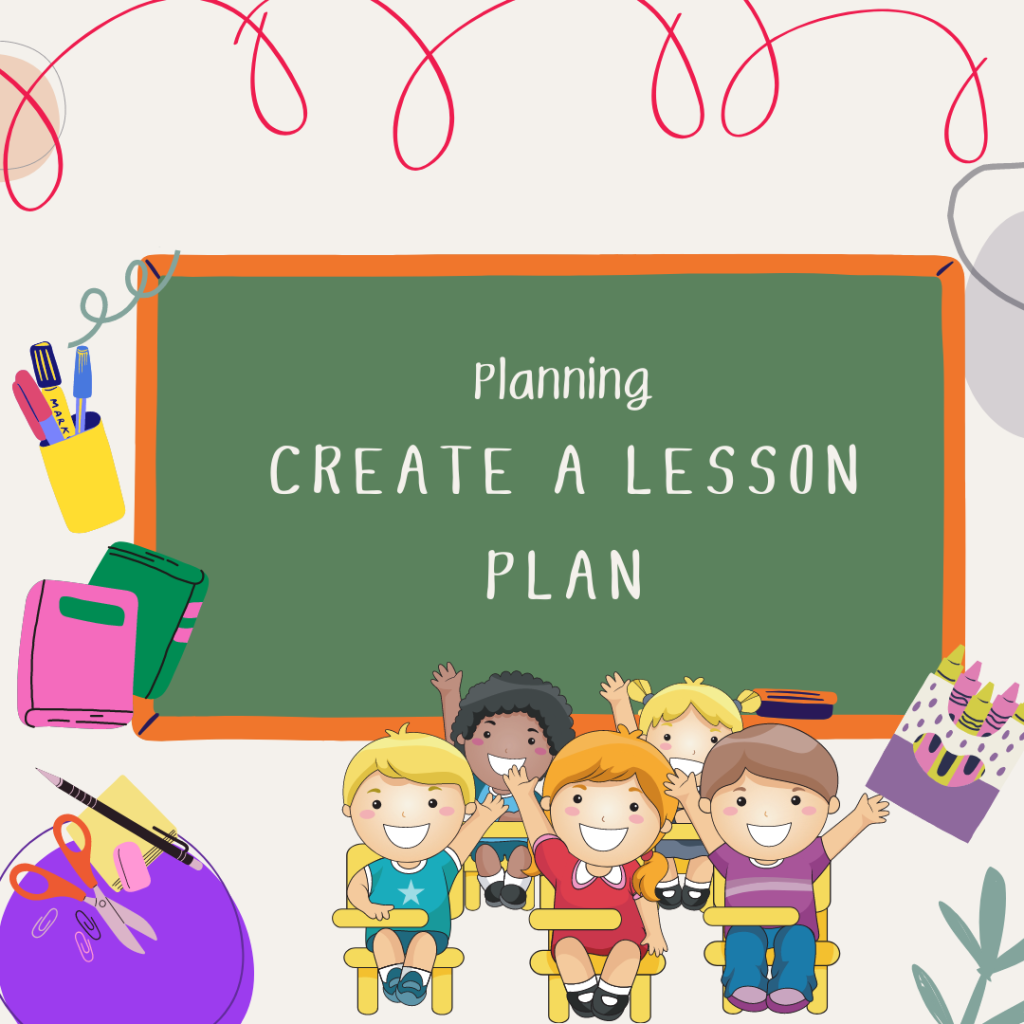
To set your work plans, you can make arrangements for the following:
-
- Lesson plan – detailed outline serves as a basis of your weekly, monthly, or yearly lessons from what and how to teach the students until the assessments.
-
- School Calendar – helps to remind you of the lesson to be thought in a certain schedule. It also contains programs, activities, and meetings for the whole year.
-
- To-do list – a list that helps you to keep track of the work that needs to be done based on priorities or urgencies. Prevents you from omitting and forgetting things or works.
-
- Routines – sets tasks or workflow to get things done in order.
-
- Outdoor Activities – activities outdoors can bring different experiences than being inside a room. Bringing nature and experiencing what nature has to offer while being able to help the kindergarteners learn the fundamentals then the nature as well.
-
- Field Trips – field trips are fun and exciting. Being able to see a different views and being in a different environment can give good core memories.
-
- Conference – notes are important because it serves as the basis of what has been settled during the meeting and what’s left to be discussed. This is also the best time to talk about the students and talk about their progress.
Settings and Environment
When children meet the age that they need to attend classes, most of them are looking forward to what their classroom looks like, will there be toys? A pool? Or chairs and tables? Always remember that classroom will be their “second home”, hence, preparing and putting a lot of effort in order to provide a better and inviting environment for them is our goal.
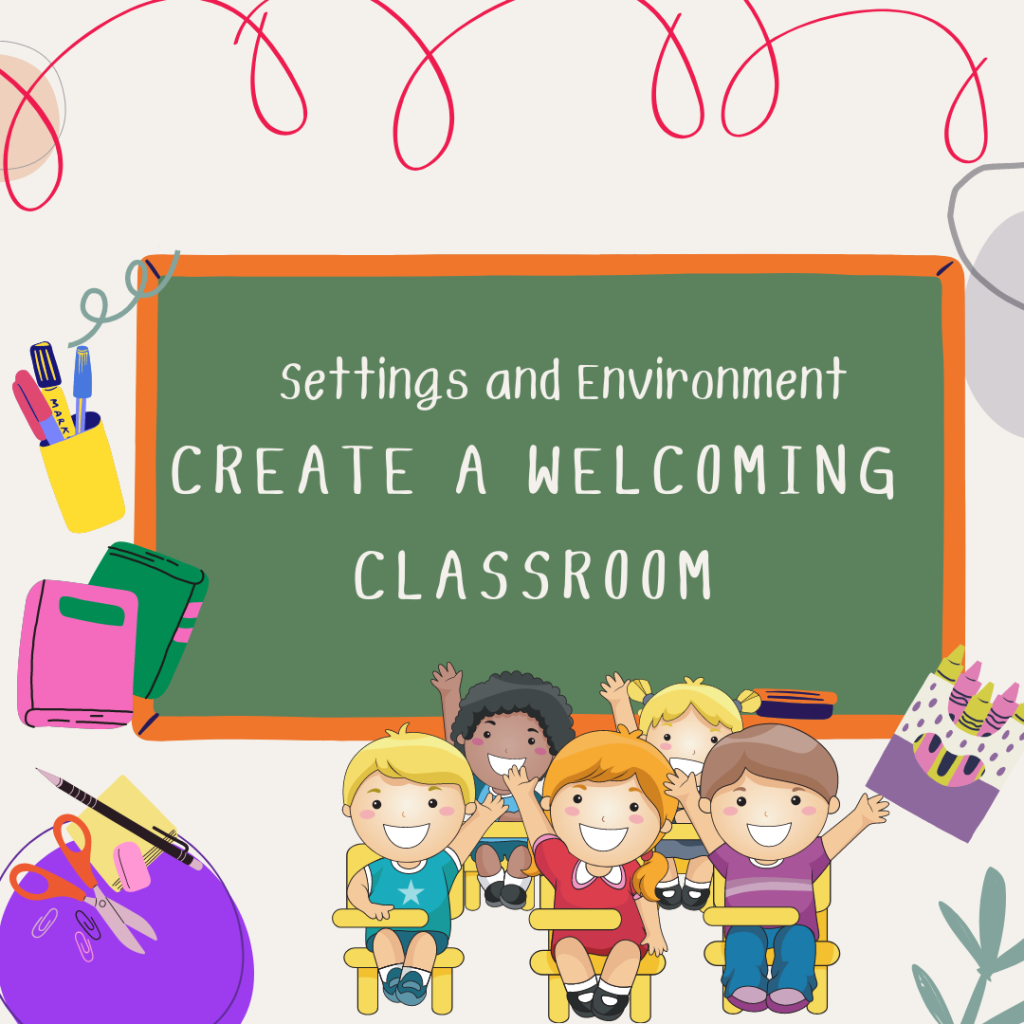
There are important things we should remember in designing a classroom for kids ages 5 to 6 years old and below.
-
-
- First, make sure that the place is spacious. Always think of the number of children that will enter the classroom. Make sure that the place will not restrict them from moving freely. Additionally, good ventilation is a must, especially at this time, classrooms must have windows and fan.
- Next, make sure that there is no hiding place. Kindergarten is a bunch of kids that the energy will last until they go home. It is safe that you can oversee these kids and no hiding spot that they can run off.
- Third, putting labels on their tables with their name and picture will help you arrange where to sit. Plus, kids will feel that they have their own space even in their classrooms.
- Fourth, create labels for things that can be found inside the classroom, such as trash bins, books shelves, and other materials. Labeling is vital according to Cinthya Quintana, as it serves as the “precursor” to reading, children who can match a picture to a toy eventually be able to read labels on their own, regardless of their grade level. Labeling is especially important in the classroom because it provides visual cues to the location of items.
- Fifth is to decorate your classrooms. Put something that is appealing to the eyes of younger children. You can put chair covers that will serve as extra storage, display the artwork of children through bulletin board, this will motivate them to be more creative as their work is appreciated. Also, you may try to put chairs that are comfortable for sitting, remember that the classroom will be their second home, so being comfy while learning and having fun will maintain their enthusiasm to learn and attend class every day.
- Lastly is to create a “magical door” Did we mention that your classroom must be welcoming to the children? Hence, creating a magical door will encourage them to enter the classrooms even without their parents around. Children’s imagination is unbelievable, why not use them for their own good?
-
Now that we already know what things to consider in creating a classroom, let us now talk about what are the materials and supplies that we can put inside. Sure, a board, chalk, and pens are all the primary things. But what are the other things that we should consider putting inside?
-
-
- First on our list is the calendar. By reviewing the date, the day of the week, the month, and yesterday/today/tomorrow, calendar time aids children in their understanding of time. Consider incorporating your daily schedule into this time as well. To avoid meltdowns and disruptions, children need a clear picture of the day’s events.
- Next is math-related designs, children’s mental math, computation, and communication abilities will improve as a result of daily number talks. Using these Daily Math Talk Cards, you can engage your students with open-ended questions, tasks, problems, and more!
- Nursery rhymes are also good display in walls on classroom. A child’s ear for language is developed through the repetition of nursery rhymes. Learning to read is made easier for kids when they can hear the syllables and sounds in words through the use of rhyme and rhythm!
- Counting charts will also add colors to the room. Expect that you will be counting nonstop with these young children, hence displaying these numbers will help them remember.
- You might also want to display a question every day. Believe it or not asking questions to young children will be beneficial to them. Asking great questions allows you to examine how much of your teaching and training is absorbed by a child. Even if these children are not actively embracing anything, it makes sense to take a moment to see what they are and how.
- Dance and Music, people’s bodies and minds can benefit from listening to music, according to numerous studies. Both the left and right brains can be activated simultaneously by listening to music, which has been shown to improve learning and memory.
- The Writer’s Workshop is on our seventh list. Not all writing instruction for young children is as straightforward and simple. The best advice I can give is to set up a writing centre that encourages students to write and/or draw right from the beginning. Rather than correcting mistakes, this area is ideal for promoting positive experiences with writing.
- Books and Library will be the eight things to consider. It is possible to have a large or small library in a classroom. There was a front-facing bookshelf with 15-30 books on the current theme in my classroom library. That’s all there is to say about it. Bean bag chairs, a small rug and pillows made it an inviting place for them to curl up with a book and relax.
- Flashcards for Learning Letters and Numbers are on the ninth list. Number flashcards can be used in a variety of settings, including a math center, a pocket chart, a number line, a 100s chart, or simply to keep on a small binder ring for parent volunteers to review with the children as they work on number identification and assessments. Alphabets can be composed of letter identification, sound assessments, and writing centers.
- . Display of family photographs, ever heard of the family day? Kindergarteners are attached to their parents, hence, displaying their family pictures might help them move forward. Identifying the people in the family photo is a favorite pastime for children. It’s a great way to get kids to get to know each other in kindergarten.
-
There is so much more to add to classrooms that will help these children be engaged in learning. Putting educational toys can also be helpful and will add colors to the four corners of the room. Be creative and have fun designing!
Class Management
Do you remember having house rules at your home? Such as, dinner should start at seven o’clock and dirty laundry should be put at the right place? Well, creating house rules inside the classroom will also be beneficial. Even though some children might not be able to read and comprehend yet, it is advisable to display these rules in front of the classrooms.
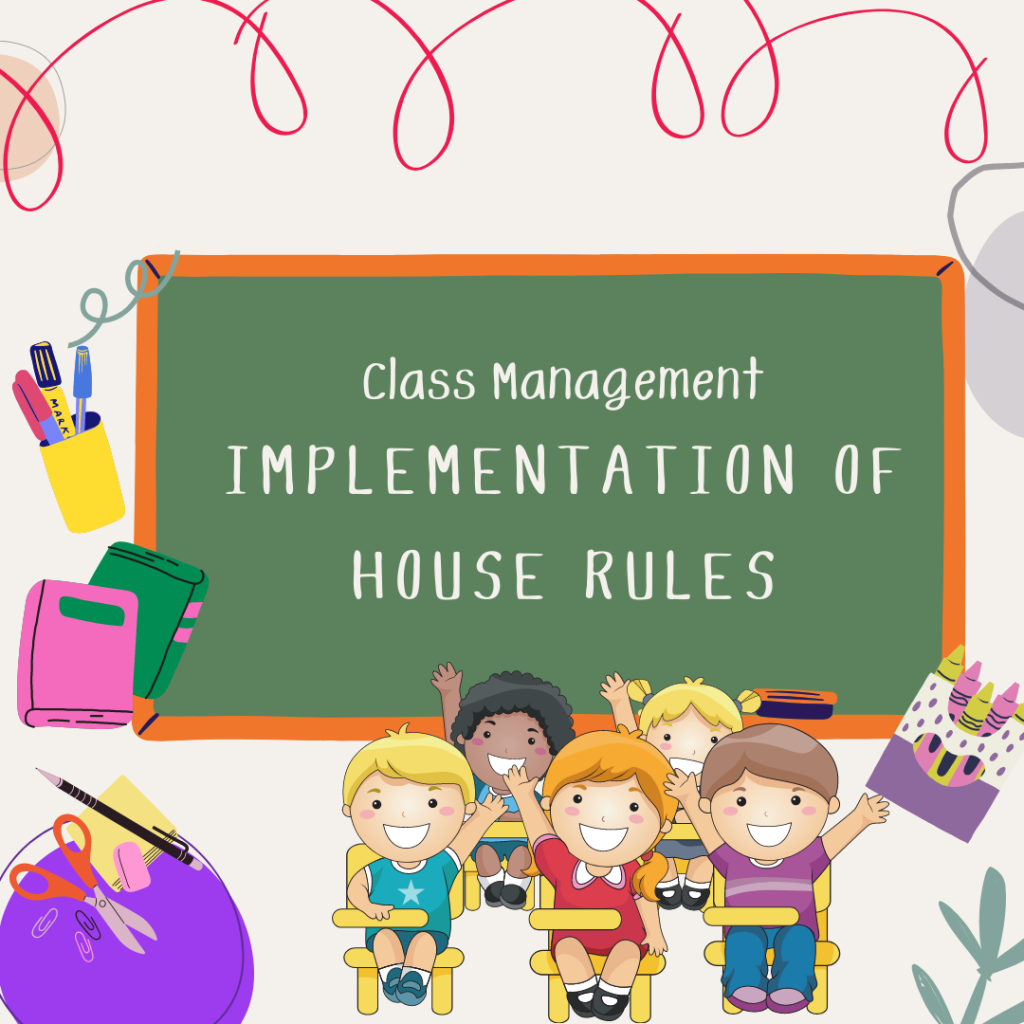
The following are other tips and tricks in order to implement rules inside your classrooms.
-
-
- First, and very important, is to involve your children in creating rules. Ask them what they think are the Dos and Don’ts inside the classroom, how they should interact with each other, and why these rules and important.
- Next, storytelling. Inspire them with stories that will discuss these rules and tell them the stories about good behavior.
- Third, children also have their own expectations, what they want to experience and learn. Hence, asking them about their goal and expectations will help you how to approach them and what teaching skills you should apply to reach the objectives.
- Fourth, establish fun yet strict participation requirements. Children must be able to actively participate in class if they want to get the most out of it.
-
Here are some examples of house rules that promote good behavior you might want to consider:
-
-
- Pay attention to what others have to say.
- Follow the instructions as quickly as possible.
- If you’d like to speak, raise your hand.
- Recognize the importance of treating everyone with dignity and decency, especially in the context of school.
- Be careful, kind, and honest.
-
You might say, some words in these rules are deep and might hard for children to understand, well you have to make every rule simple. Use simple words, and make sure that children can follow.
Teaching Tips
We all know that teaching kids could mean everything at once. Their minds and bodies are too active and may get rowdy that adults may not be able to keep up. But do not fret, there are a lot of ideas and techniques we could use to remain on the path of knowing while keeping a fun, disciplined, and safe environment.
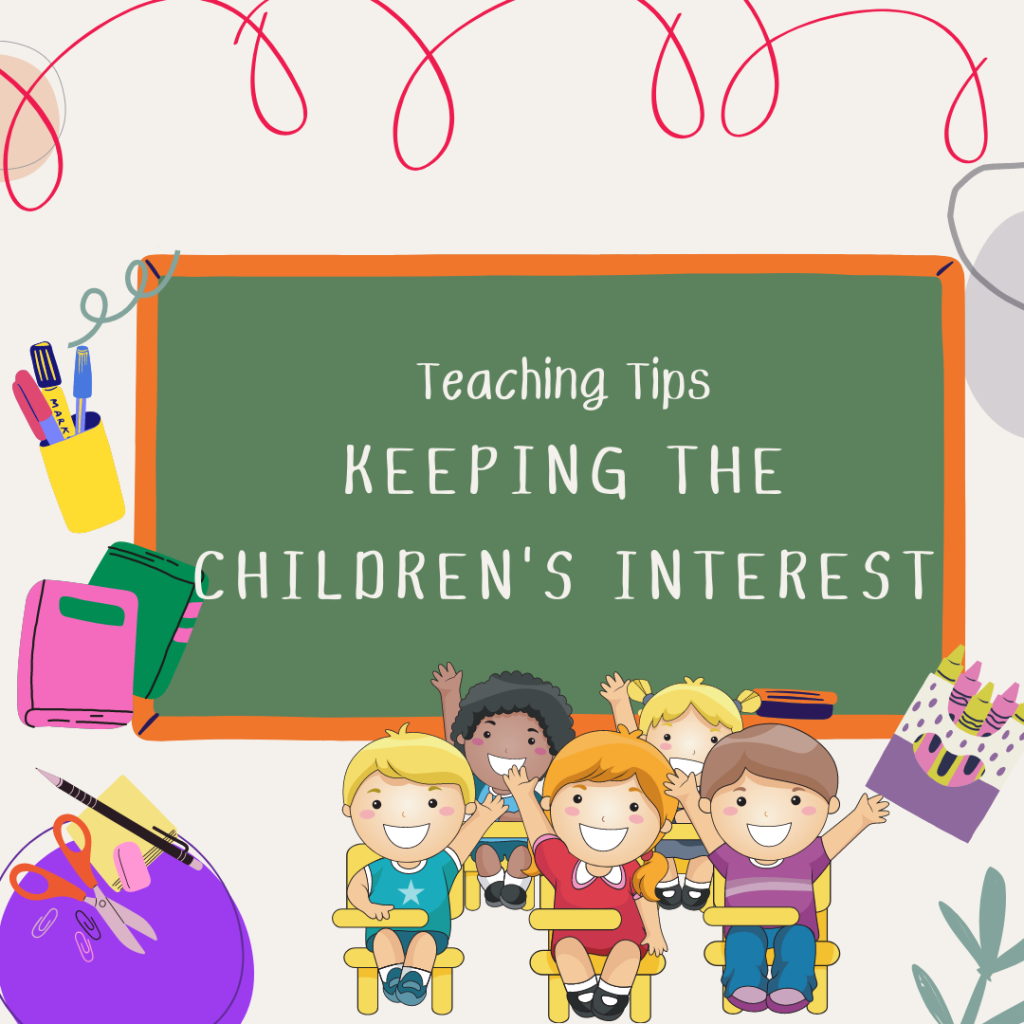
We can recommend several tips that can keep the kindergarteners’ interest to learn:
-
-
- Make science experiments and projects that can make cause and effect output.
- Use music in almost all lessons or lectures. Information is easily absorbed when accompanied by music or sound (mnemonics)
- Make STEM challenges in between lectures or at the end of lectures to keep them learning and anticipating for a fun game.
- Keep them practicing writing and scribbles.
- Use a personification to things or use characters they love to hook them up during class work or during lecture.
- Post images (animals, shapes, famous people, famous places) and sight words at the rear and back of the room to get familiarized.
- Bring ‘safe for children’ devices or technologies that they can observe and try.
- Use themes to hook them up for learning. Fun and creative structures are good for them to keep them interested.
- Make fun group work or group activities such as role plays, tag teams.
- Incorporate math lessons with the help of real things such as pop sticks, blocks.
- Try to make the kindergarteners watch interactive videos or videos where the fundamental subjects (math, science, reading and writing, social studies, etc) are being taught.
- Learn shapes hands on where they can feel the edges or the texture of it.
- Make a trip outside to know about the environment and have first-hand experiences. Most kindergarten destinations happened to be in zoos or museums.
-
Social Interactions and Challenges
When a child is engaging to a conversation or interacting with other people, it enhances their speech and familiarity to the words and the person they are conversing with. Making friends is fun but also challenging when cultural differences are brought up. Socializing can also be challenging for some kids, especially those who are not fond of meeting new people, that’s why we must also take precautions or fun games for them to interact with others without tensions.
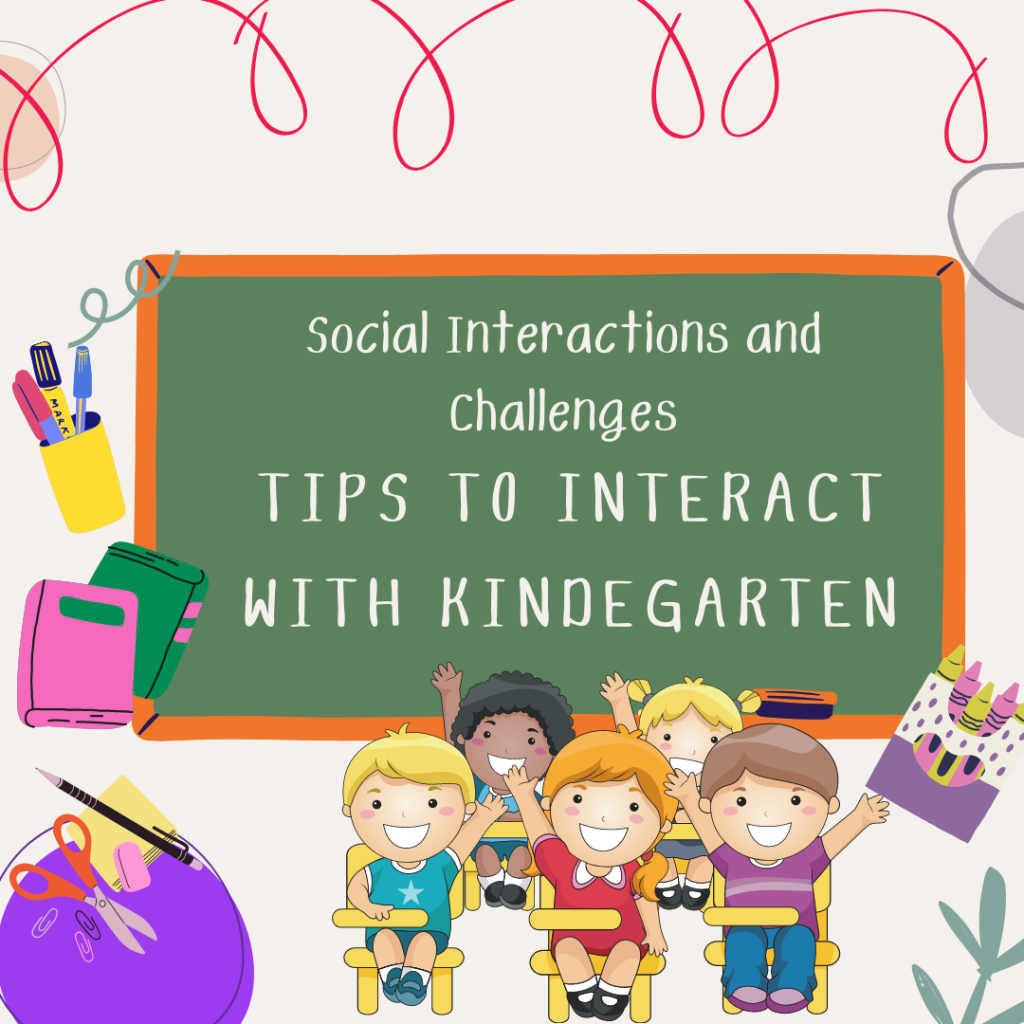
Here are the 5 best ways to interact to a kindergartener as an adult:
-
-
- Listen, talk, and understand what they are saying and connect to them. Be always open for them to feel your care. You can try asking how their day was, did they have fun etc.
- Praise them always for every job done and give encouragement to lift up their spirits
- Know how to support them in their learning and hobbies. Provide emotional support and create bonds like playing as a family.
- When dealing with sensitive or tough topics, make them feel and understand that you’ll always be there to listen. Always try to explain in simplest terms or simple language.
- Talk in a calm voice and don’t put them into stress as much as possible.
-
Also, there are existing and uncontrollable challenges for kindergarteners. These are:
-
-
- Bullying
- Racism
- Being fun of or picked on a fight
- Unintentional physical injuries
- Psychological disorder
- Being the odd one
-
While the adults can easily understand such differences but the children do not actually know how to react with it. Some reactions are based on what they have observed on shows, at home, or the environment. When you see any signs of this situations, call the respective people to stop and settle. If these happenings caused trauma to the child, take them to your family doctor or a psychiatrist.
Maintaining Self-Composure
We mentioned in this article that kindergarten is the stage where they are curious and has a lot of energy store in their bodies. Physical activities are also important for these children to learn, so that they know how to use the energy they have. You should know what to anticipate if you are handling kids under six years old. Expect that teaching them will not be easy, challenging, but fun. There are huge differences between kindergarten and other higher academic levels. In the higher level, if a child does not fully understand what you teach, you can always teach the basics, however, in kindergarten you teach the basics, such as reading alphabets, and counting numbers. That is why it is really difficult.

This is also the start where you teach them to develop their social skills, at first day they might not know how to follow the instructions very well, they might not know how to have conversation with their peers, and you will guide them all through this.
With all these challenges, you should compose yourself to be more patient and understanding. Take time to rest, and to feel the best before facing these young children. If you follow this, it is less likely for you to feel frustrated easily.
The following are the tips and reminders related to maintaining self-composure:
-
-
- Kindergarten can be easily overwhelmed, hence, if you show your frustrations to them, they will now take it good. Additionally, children who are exposed to new environment will feel shy and overwhelmed.
- The average attention span of under five years old is approximately 10 to 25 minutes. This is according to Child Developmental experts. And it still depends on the activity and task they are going to accomplish. They can be easily distracted. Prior to launching into your speech, make sure everyone is focused on you. Even if it seems like a long time, try to be patient and wait until the entire class is focused on what you have to say. As students become more familiar with their roles, this will become less of a challenge. You may say “put your finger on your ear to tell if you can hear what I’m saying”
- Accept that you are also a human that might get overwhelmed and frustrated when the time comes, if that’s happen, please do not show this to these children. Ask for a substitute teacher while you are on the break. Meditation will also be helpful.
- Bring extra clothing for children in case of an accident, you may also ask parents to bring extra clothes for their child.
- Always keep water beside you, as we have mentioned these children are so energetic, hence, you have to be hydrated.
- Last reminder is to SMILE, yes, teaching kindergarten can be really tough. But knowing that you are the reason why they are learning everyday can be really fulfilling. You are basically their foundation of knowledge, you teach them basics, and you make them enthusiastic in learning. That is why, keep on smiling, everyday seems like an adventure and you are along with the kids are the main characters. You got this.
-
Conclusion
-
-
- Learning about worksheets and worksheets for kindergarten gave me a fun roller coaster ride knowing all the possible discussions we could encounter. As we come to the end of the discussion, we now need to make a recap and summary of the article entitled “All Things you Need to Know About Kindergarten.”
- Worksheets are assessment tools providing concise instructions and information, best used as supplements for textbooks.
- Kindergarten subjects or topics such as Math, Fine Arts, Foreign Language, Reading and Writing, Science, Social Studies, Social-Emotional, and Typing are fundamental subjects beneficial for kindergarteners’ developmental process and milestones.
- The Kindergarten curriculum focuses on enhancing fine motor skills, cognitive capacity, and gross motor skills.
- Worksheets for kindergarteners are very efficient and fit for a child’s learning process since they consist of a few papers at most to answer the question or do the tasks.
- Worksheets save time and effort for educators and parents. It is way easier to teach the kindergarteners alongside worksheets than through textbooks and modules only.
- Canva is one of the most used and helpful websites that we can utilize to create a do-it-yourself worksheet.
- Canva offers a lot of features and templates, some might need premium access, and some might be free.
- PDF can also be made editable. With the help of PDF Escape.
- PDF Escape is a free tool that can be used to make editable PDFs. It has several features that it offers to its users. You can put text, and checkboxes, and even edit its font style and size.
- Other features of free PDF Escape are; Edit PDF files, annotating PDF Documents, filling out PDF Forms, creating basic PDF Forms, Password Protect PDF Files, Share Documents Online, and viewing PDF files.
- PDF Escape premium, on the other hand, offers a lot more. It includes all the Free PDF Escape versions and they added the following, edit text and image, print to PDF, MERGE pdf documents, convert PDF to Word and other formats, Watermark and add page numbers, and compress PDF File sizes.
- KindyVerse is a website that offers free worksheets and they have tips and goals for educators.
- KindyVerse also offers worksheets for different grade levels, and these are Preschool, Kindergarten, 1st grade, 2nd grade, and 3rd grade.
- KindyVerse also has several topics to offer, these are;
- Alphabet
- Writing
- Coloring pages
- Reading
- Chess
- Games
- Nursery Rhymes
- Social Studies
- Science and
- English for beginners
-
-
-
- These topics consist of different activities, for example in the alphabet, there is writing and tracing letters.
- Worksheets can be used not just by sitting but also by doing activities such as snowball.
- There are things to consider to properly use a worksheet. One piece of advice is to give worksheets based on the age level of children. Also, do not force your children to learn, learning should be fun and not a punishment.
- It was also mentioned in this article the differences in the way a young child holds a pencil. It was categorized based on their age.
- During one-year-old children can hold pencils in Fisted Grasp, two-year-olds hold in Palmer Grasp, three-year-olds hold in Static Tripod or Quadruped Grasp, and the final stage is Dynamic Tripod Grasp.
- There are a lot of teaching strategies wherein worksheets are involved. These strategies are; Planning, Settings and Environment, Class Management, Teaching Tips, Social Interactions, and Challenges, and Maintaining Self-Composure.
-
The child is practicing her movements, trying to learn about their surroundings, and learning to react to the people around them. They gain senses so they begin to get curious and work on their intuition. Little by little, they practice hand and eye coordination.
